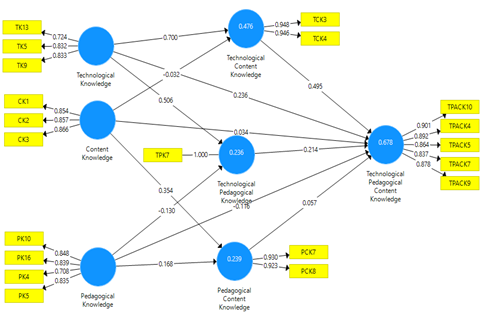Analysis of TPACK (Technological Pedagogical and Content Knowledge) variables for middle school teachers through surveys in the Pasar Jambi district
DOI:
https://doi.org/10.12928/jrkpf.v10i1.198Keywords:
TPACK, Structural Equation Model-Partial Least Square (SEM-PLS), TPACK competencyAbstract
This study aims to analyze the influence of TPACK variables on junior high school teachers in Pasar Jambi District. The type of research used is quantitative research with a survey approach via WhatsApp groups and filling out questionnaires via google forms. The data collection technique used a questionnaire and then analyzed using the Structural Equation Model-Partial Least Square (SEM-PLS) method with SmartPLS software. From the results of the analysis, there are 5 out of 12 variable relationships that have a significant effect. Seven variables do not have a considerable impact: CK variables on TCK, CK on TPACK, PCK variables on TPACK, PK variables on PCK, PK variables on TPACK, PK variables to TPK, and TPK variable to TPACK. This shows that pedagogical and content knowledge does not significantly influence the teacher's TPACK ability. This research is expected to improve teacher TPACK competence, especially in technological knowledge, because teacher TPACK abilities are strongly influenced by technological knowledge.
References
F. Farikah and M. M. Al Firdaus, "Technological Pedagogical and Content Knowledge (TPACK): The Students' Perspective on Writing Class," J. Stud. Guru dan Pembelajaran, vol. 3, no. 2, pp. 190-199, Aug. 2020, doi: 10.30605/jsgp.3.2.2020.303. https://doi.org/10.30605/jsgp.3.2.2020.303
D. Ilham, "Menggagas Pendidikan Nilai dalam Sistem Pendidikan Nasional," Didakt. J. Kependidikan, vol. 8, no. 3, pp. 109-122, 2019, doi: 10.58230/27454312.73.
A. Y. Wulandari, "Profesionalisme Guru dalam Pembelajaran Daring di Era Pandemi Covid 19," Kalam Cendekia J. Ilm. Kependidikan, vol. 10, no. 2, p. 296, Oct. 2022, doi: 10.20961/jkc.v10i2.65633. https://doi.org/10.20961/jkc.v10i2.65633
U. Syaidah, B. Suyadi, and H. M. Ani, "Pengaruh Kompetensi Guru Terhadap Hasil Belajar Ekonomi di SMA Negeri Rambipuji Tahun Ajaran 2017/2018," J. Pendidik. Ekon. J. Ilm. Ilmu Pendidikan, Ilmu Ekon. dan Ilmu Sos., vol. 12, no. 2, pp. 185-191, 2018, doi: 10.19184/jpe.v12i2.8316. https://doi.org/10.19184/jpe.v12i2.8316
M. A. Thohir, E. Ahdhianto, S. Mas'ula, F. April Yanti, and M. I. Sukarelawan, "The effects of TPACK and facility condition on preservice teachers' acceptance of virtual reality in science education course," Contemp. Educ. Technol., vol. 15, no. 2, p. ep407, Apr. 2023, doi: 10.30935/cedtech/12918. https://doi.org/10.30935/cedtech/12918
Ramaliya, "Pengembangan Kompetensi Guru dalam Pembelajaran," Bidayah Stud. Ilim. Keislam., vol. 9, no. 1, pp. 77-87, 2018.
W. T. Sumar, N. Lamatenggo, and I. A. Razak, "Strategi Guru dalam Implementasi Pembelajaran Abad 21 Melalui Model Pembelajaran Daring untuk meningkatkan Kompetensi Guru," Jambura Elem. Educ. J., vol. 1, no. 2, pp. 100-110, 2020.
A. Hayati Rahayu, A. Widodo, U. Syaefudin Sa, U. Sumedang, and J. Anggrek Situ, "Analisis TPACK Mahasiswa PGSD UNSAP Sumedang," J. Elem. Educ., vol. 05, no. 01, pp. 30-38, 2022.
E. Tarihoran, "Guru Dalam Pengajaran Abad 21," SAPA - J. Kateketik dan Pastor., vol. 4, no. 1, pp. 46-58, May 2019, doi: 10.53544/sapa.v4i1.68. https://doi.org/10.53544/sapa.v4i1.68
Zulham, "Penerapan Teknologi Informasi Menentukan Keberhasilan Dunia Perusahaan Industri," J. War., vol. 53, no. 9, 2017.
W. Purnawati, M. Maison, and H. Haryanto, "E-LKPD Berbasis Technological Pedagogical Content Knowledge (TPACK): Sebuah Pengembangan Sumber Belajar Pembelajaran Fisika," Tarbawi J. Ilmu Pendidik., vol. 16, no. 2, pp. 126-133, 2020, doi: 10.32939/tarbawi.v16i2.665. https://doi.org/10.32939/tarbawi.v16i2.665
P. Mishra and M. J. Koehler, "Technological Pedagogical Content Knowledge: A Framework for Teacher Knowledge," Teach. Coll. Rec. Voice Scholarsh. Educ., vol. 108, no. 6, pp. 1017-1054, Jun. 2006, doi: 10.1177/016146810610800610. https://doi.org/10.1177/016146810610800610
A. Nasar and M. H. Daud, "Analisis Kemampuan Guru IPA Tentang Technological Pedagogical Content Knowledge pada SMP/MTs di Kota Ende," Opt. J. Pendidik. Fis., vol. 4, no. 1, pp. 9-20, 2020, doi: 10.37478/optika.v4i1.413. https://doi.org/10.37478/optika.v4i1.413
M. Maidiana, "Penelitian Survey," ALACRITY J. Educ., pp. 20-29, Jul. 2021, doi: 10.52121/alacrity.v1i2.23. https://doi.org/10.52121/alacrity.v1i2.23
E. Yunitasari, A. Triningsih, and R. Pradanie, "Analysis of Mother Behavior Factor in Following Program of Breastfeeding Support Group in the Region of Asemrowo Health Center, Surabaya," NurseLine J., vol. 4, no. 2, p. 94, Feb. 2020, doi: 10.19184/nlj.v4i2.11515. https://doi.org/10.19184/nlj.v4i2.11515
N. Susanti, Hadiyanto, and A. Mukminin, "The Effects of TPACK Instrument Variables on Teacher Candidates in Higher Education," J. High. Educ. Theory Pract., vol. 22, no. 2, pp. 107-115, 2022, doi: 10.33423/jhetp.v22i2.5041. https://doi.org/10.33423/jhetp.v22i2.5041
Y. dan M. Kusnadi, "Pengaruh Keterimaan Aplikasi Pendaftaran Online Terhadap Jumlah Pendaftar di Sekolah Dasar Negeri Jakarta," J. Paradig., vol. XVIII, no. 2, pp. 89-101, 2016.
B. Wiitavaara and M. Heiden, "Content and psychometric evaluations of questionnaires for assessing physical function in people with low back disorders. A systematic review of the literature," Disabil. Rehabil., vol. 42, no. 2, pp. 163-172, Jan. 2020, doi: 10.1080/09638288.2018.1495274. https://doi.org/10.1080/09638288.2018.1495274
J. F. Hair Jr, M. Sarstedt, L. Hopkins, and V. G. Kuppelwieser, "Partial least squares structural equation modeling (PLS-SEM)," Eur. Bus. Rev., vol. 26, no. 2, pp. 106-121, Mar. 2014, doi: 10.1108/EBR-10-2013-0128. https://doi.org/10.1108/EBR-10-2013-0128
D. D. Agyei and J. M. Voogt, "Exploring the potential of the will, skill, tool model in Ghana: Predicting prospective and practicing teachers' use of technology," Comput. Educ., vol. 56, no. 1, pp. 91-100, Jan. 2011, doi: 10.1016/j.compedu.2010.08.017. https://doi.org/10.1016/j.compedu.2010.08.017
D. L. Trenggonowati and K. Kulsum, "Analisis Faktor Optimalisasi Golden Age Anak Usia Dini Studi Kasus di Kota Cilegon," J. Ind. Serv., vol. 4, no. 1, Oct. 2018, doi: 10.36055/jiss.v4i1.4088. https://doi.org/10.36055/jiss.v4i1.4088
V. Arvianto and W. Usino, "Analisis Pengaruh Kualitas Sistem Informasi, Kualitas Informasi dan Perceived Usefulness Terhadap Kepuasan Pengguna Aplikasi Olibsifrs (Psak) 71 (Studi pada Bank Papua)," J. Indones. Sos. Teknol., vol. 2, no. 11, pp. 2082-2098, Nov. 2021, doi: 10.36418/jist.v2i11.271. https://doi.org/10.36418/jist.v2i11.271
R. A. Peterson and Y. Kim, "On the relationship between coefficient alpha and composite reliability.," J. Appl. Psychol., vol. 98, no. 1, pp. 194-198, 2013, doi: 10.1037/a0030767. https://doi.org/10.1037/a0030767
I. M. A. Arya Pering, "Kajian Analisis Jalur Dengan Structural Equation Modeling (Sem) Smart-Pls 3.0," J. Ilm. Satyagraha, vol. 3, no. 2, pp. 28-48, Aug. 2020, doi: 10.47532/jis.v3i2.177. https://doi.org/10.47532/jis.v3i2.177

Downloads
Published
Issue
Section
License
Copyright (c) 2023 Tri Windianingsih, Nova Susanti, Alrizal

This work is licensed under a Creative Commons Attribution-NonCommercial 4.0 International License.







